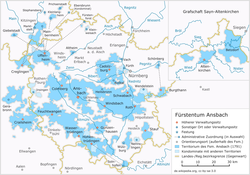Ansbach-Bayreuth
| Margraviate of Brandenburg-Ansbach / Principality of Ansbach | ||||||||||
| Markgrafschaft Brandenburg-Ansbach / Fürstentum Ansbach | ||||||||||
| State of the Holy Roman Empire | ||||||||||
|
||||||||||
|
The principality of Brandenburg-Ansbach as of 1791, superimposed over modern borders
|
||||||||||
| Capital | Ansbach | |||||||||
| Languages | East Franconian | |||||||||
| Government | Principality | |||||||||
| Historical era | Early modern period | |||||||||
| • | Nuremberg became Imperial City |
1219 |
||||||||
| • | Partition of burgraviate |
21 January 1398 |
||||||||
| • |
Personal union with Brandenburg |
1415–40 |
||||||||
| • | Reunion with Bayreuth |
11 June 1420 |
||||||||
| • | Repartition | 21 September 1440 | ||||||||
| • | Restoration of personal union |
1470–86 |
||||||||
| • | Margraviate sold to Prussia |
2 December 1791 |
||||||||
| • | Formal annexation | 28 January 1792 | ||||||||
|
||||||||||
| Today part of |
|
|||||||||
The Principality of Ansbach (German: Fürstentum Ansbach) or Markgraftum Brandenburg-Ansbach was a reichsfrei principality in the Holy Roman Empire centered on the Bavarian city of Ansbach. The ruling Hohenzollern princes of the land were known as margraves, as the principality was a margraviate (but not a march).
The principality was established at the death of Frederick V, Burgrave of Nuremberg, on 21 January 1398, when his lands were partitioned between his two sons. The younger son, Frederick VI, received Ansbach and the elder, John III, received Bayreuth. After John III's death on 11 June 1420, the two principalities were reunited under Frederick VI, who had become Elector Frederick I of Brandenburg in 1415.
Upon Frederick I's death on 21 September 1440, his territories were divided between his sons; John received the principality of Bayreuth (Brandenburg-Kulmbach), Frederick received Brandenburg, and Albert received Ansbach. Thereafter Ansbach was held by cadet branches of the House of Hohenzollern, and its rulers were commonly called Margraves of Brandenburg-Ansbach.
...
Wikipedia


